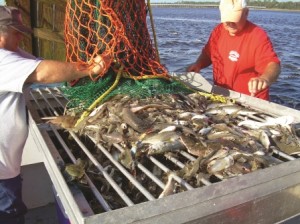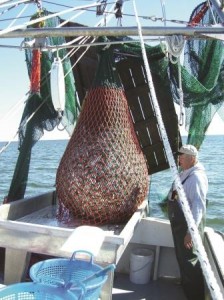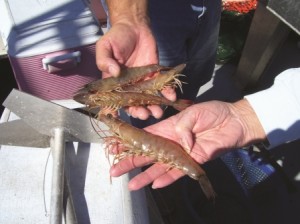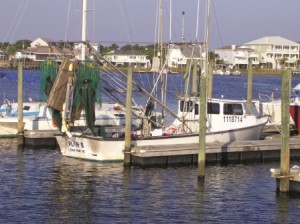How To Set Up A Shrimp Trawl
By E-CHING LEE

Bars on the top grate catch larger bycatch from the internet, while the smaller grate stops more unwanted take hold of from falling to the bottom of the culling table. Photo by Nick Morgan.
During the holidays, visions of shrimp may trip the light fantastic in many heads, from shrimp cocktail to shrimp towers to shrimp kebabs. But while information technology might be easy to pluck these crustaceans from festive platters, harvesting them from state waters is more involved.
In North Carolina, lesser trawlers take hold of shrimp by pulling nets in tows that typically last xxx minutes or longer. Once they bring the catch on lath, shrimpers have to sort through their haul, which is time and labor intensive. Likewise shrimp, their load often includes unintended grab, or bycatch, such as sharks, rays and jellyfish that have to be returned to the h2o.
Hauls with a lot of bycatch reduce trawler fuel efficiency and increase the time needed to manually cull the catch. In some instances, loftier bycatch-to-shrimp ratios may result in bruised or crushed shrimp, producing an inferior-quality production.
John Broome, a Wilmington-based shrimper, conducted two projects that tested shrimp gear changes. His research ideas were supported by the N.C. Fishery Resource Grant Plan. The Deutschland programme, equally it as well is known, is administered by North Carolina Bounding main Grant.
"We proposed to come with new gear that would assistance united states of america cull the catch out faster and besides become the bycatch back into the water faster," Broome explains. Quick processing preserves the quality of the shrimp and helps the bycatch survive.
"When you have bycatch, I call up it'southward important to get it back into the h2o and effort to keep everything alive," he continues. "It's adept for the industry and information technology'southward good for the environment."
Scott Baker, Sea Grant fisheries specialist, sees a win-win situation. "This is a case where shrimpers and fishery managers want the same thing: Make the shrimp fishery both more efficient and more selective in the harvest of shrimp," he says.
A GRATE-FULL OF Grab
Broome'due south initial FRG project added two grates and a flooding method to his culling process in an attempt to reduce the sorting fourth dimension for shrimp and bycatch. This iii-part culling process could be used individually or in combination. He bottom-trawled in the ocean betwixt Carolina Beach and Oak Island, and in the Cape Fear River.

Broom reported that the 20inch, reduced-grid turtle excluder device was meliorate in reducing bycatch and minimizing shrimp loss, and often resulted in lighter hauls with lower bycatch-to-shrimp ratio than the standard 4-inch TED. Photo by Nick Morgan.
"The whole purpose is to minimize the unwanted attribute of shrimping, which is dealing with bycatch," Bakery explains.
Another intention was to preserve the quality of the shrimp through quicker culls. "The sooner you tin get the bycatch separated, the sooner y'all tin get the shrimp into their final identify — whether that's ice or alkali or anything to get information technology candy," he adds.
First, Broome built a culling efficiency sorter, or CES, which was a grate with bars spaced ii inches autonomously, for the superlative of his culling box. When he emptied the tailbag — which is the end of the net where the shrimp are caught — on the table, the CES trapped the bigger bycatch while the smaller shrimp brutal through.
"Before it even got to the bottom of the box, we were able to capture a lot of the bycatch," he recalls. Broome and his mate removed marketable fish before scraping other fish and debris into the h2o with alternative rakes. The height CES allowed Broome to return unwanted species apace to the water, ensuring lower bloodshed for bycatch.
It was a work in progress, as he adjusted his methods throughout his trawls to find a workflow that would brand culling safer and more efficient. Initially, he used a shaker motor to motion the shrimp off the grate. However, when he plant that the vibrations caused more than bycatch to drop into the culling tabular array, he stopped using information technology.
2d, Broome flooded the box in hopes that the fish would bladder and the shrimp would remain at the lesser of the table. Although this method didn't work as well as expected, the water had several advantages.
Quickly flooding the shrimp helped preserve their quality past cooling them and reducing bacterial activity, particularly if the shrimp had died. Further, the water lifted the heavier fish off the smaller crustaceans, reducing the chances of the shrimp being hobbling and easing the process of separating the shrimp from bycatch.
Finally, Broome had another grate at the lesser of the table with i-inch separations between the bars that he would enhance to remove more bycatch. At the end of this process, "nosotros were left with almost pure shrimp sometimes," he notes, which was practiced for the shrimp — and for his concern.
"When y'all're culling, you're having to go through everything and you're using culling rakes and you lot're pulling things through. I call up that it just seemed to me that the shrimp were not bruised or damaged every bit much because you didn't have that much material to sort through. It seemed to me similar a better-quality product," Broome says.
Bakery agrees. The CES is "good at removing big items quickly and may remove some other items also. And, although non tested, by having a wet alternative table, it basically allows the shrimp to be of higher quality," he adds, noting that potential future projects could measure the quality of the shrimp.
OUTSIDE THE BOX
The success of the CES got Broome thinking outside of the (alternative) box to the turtle excluder device, or TED, in his nets. "If we could eliminate a lot of the bycatch past using that top grate, why non incorporate it into the TED itself?" he asked. Federal police force requires him to use TEDs in his trawl nets to prevent turtles from getting trapped in the end pocketbook.
For his second project, Broome experimented with 2-inch spacing for his TEDs. The shrimper wanted to compare the relative effectiveness of the standard and reduced spacing. "As far every bit I know, I was the offset to employ and conduct research by comparing a 4-inch filigree TED to a 2-inch grid TED on the East Coast," he says.

Broome prides himself on providing loftier-quality shrimp to his customers. Photo by Nick Morgan.
Regulations land that iv inches is the maximum distance between the TED bars for shrimp trawls, just practice non specify a minimum spacing.
"Those bars are spaced at 4 inches because that's the width of a carapace, from belly to the pinnacle of a turtle," explains Sara Mirabilio, Sea Grant fisheries specialist. "Anything bigger than that would trap turtles." See story on page 16 for Mirabilio's project to examination a new TED blueprint for the flounder trawl fishery.
In trawl nets, the TEDs are angled to guide any turtles or other larger creatures that enter the net to an opening that allows them to escape. Smaller fish and shrimp slip through the confined of the TED into the bag end of the cyberspace.
Broome figured that a TED with smaller spacing might keep more bycatch out of his end bag. But he was concerned that the alter also might impact his grab.
"After I put up for the project and it got approved, I thought I was setting myself up for a lot of shrimp loss," Broome admits. But he plunged gamely into the research.
"The bycatch was decreased past using the smaller spacing but the shrimp take hold of was the same, which is cracking," Sea Grant's Baker notes. Less bycatch ways the shrimpers could lower their fuel costs by pulling lighter loads. In add-on, smaller hauls amend safety for the crew considering they do non take heavy nets swinging at the back of their boats.
On average, the standard TED defenseless nigh 30 pounds of shrimp per tow compared to the reduced-filigree TED that bagged 28 pounds, for a departure of two pounds. "And on over half of the tows," Broome continues, "the internet that had the ii-inch filigree really caught more shrimp." He conducted his tows between Carolina Beach and Lockwood Folly inlets.
Steve Parrish, owner of S&Due south Trawls in Supply, makes TEDs for shrimp trawlers in this country and around the world. He assembled the narrow-grid TED for Broome, just he besides builds them for many of his customers in and outside the country, with spacing varying between two and 4 inches.
Information technology was Parrish who advised Broome on the minimum spacing for his bars. "Annihilation less than two inches will crusade a swell amount of shrimp loss, especially for larger shrimp," the TED builder warns.
For his shrimp-trawling customers, reduced-grid TEDs are fairly popular. "Just about all fishermen use them at some time or another," Parrish says. They are a tool that shrimpers can use at different times of the year to reduce bycatch while maintaining their booty.
Parrish calls these narrow-grid TEDs jellyball TEDs. Broome quickly discovered why. Jellyballs are a nickname for cannonball jellyfish that are like in size and advent to their namesake missile.
"By using the 2-inch reduced-grid TED, it knocked near of the jellyballs out," Broome confirms. In addition, he could go on shrimping without having to end to unclog his TED of jellyballs.
SEEKING A WILLING Audition
In Broome's eyes, both projects were resounding successes — and he is ready to spread the give-and-take. "We conducted outreach past creating a pamphlet and distributing them at local internet shops and regional commercial line-fishing establishments," he says. As a result of his and Body of water Grant's efforts, several shrimpers have contacted Broome for more information near his gear changes.

Broome's Boat, Plan B, is a 35-foot shrimp trawler that pulls 2 identical nets separated by a sled in the middle. Photograph by Nick Morgan.
"Anybody that volition stand notwithstanding long enough, I'll tell them what a do good this is," he continues.
These days, Broome nevertheless uses the CES gear. "We flood the culling box at present and nosotros also employ the height grate. And occasionally, if we have the correct kind of bycatch — if it's smaller — we will use the bottom grate too," he explains.
In addition, he uses the 2-inch reduced-grid TED, together with a combination of the CES gear. This gives the bycatch ii chances to be culled quickly. On occasion, his alternative times are a quarter of what they would be if he didn't use either gear.
For Broome, every stride to improve the quality of his shrimp is worth it. "That's why even though that 2-inch reduced grid takes a lot of the bycatch out, I nonetheless incorporate this other [CES] method of culling and that helps fifty-fifty more," he says. Other positive side effects include safer shrimping conditions considering of lighter hauls and reduced labor costs considering there is less bycatch.
"Nosotros're getting a better-quality product and we're besides getting the bycatch dorsum into the h2o faster, so there'southward less bloodshed and that's important too," Broome adds. "The more than we can do in this industry to help the bycatch and to reduce the mortality, the better position we're in."
To read Broome's last Fishery Resource Grant reports, become to: www.ncseagrant.org. Search for 09-FEG-01 for the CES study, and for x-FEG-03 for his reduced-grid TED project. Visit: world wide web.ncseagrant.org/s/shrimp-gear for a Design summarizing Broome's recommendations.
SHRIMP FISHERY Direction PLAN UPDATE
Through September and Oct, the North.C. Division of Marine Fisheries, too known as DMF, sought public comments for its five-year revision of the Shrimp Fishery Management Plan, or FMP. Currently, one of the FMP's recommendations is to go along research in the shrimp trawl fishery and investigate how this method affects habitats.
The N.C. Marine Fisheries Commission, or MFC, can either pursue a revision, which involves updating the information and fishery-related information in the plan, or an amendment process to explore changes in management strategies. In a September announcement, DMF said that there are no plans to brand any amendments to the Shrimp FMP.
The MFC will decide how to continue with the new FMP at its November meeting. Visit: portal.ncdenr.org/web/mf for the latest information on MFC deportment.
This article was published in the Vacation 2022 issue of Coastwatch.
For contact information and reprint requests, visit ncseagrant.ncsu.edu/coastwatch/contact/.
How To Set Up A Shrimp Trawl,
Source: https://ncseagrant.ncsu.edu/coastwatch/previous-issues/2012-2/holiday-2012/in-search-of-a-better-way-adjusting-shrimp-trawl-gear/
Posted by: lewisdorie1985.blogspot.com


0 Response to "How To Set Up A Shrimp Trawl"
Post a Comment